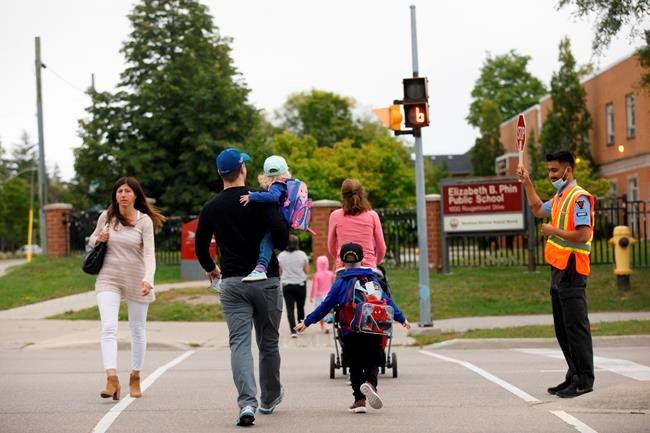Multiple provinces reported COVID-19 cases linked to schools just as thousands more students returned to class Tuesday, raising fears over what's in store for a segment of the population largely sheltered from exposure over the past six months.
The fallout from earlier openings in Alberta, Saskatchewan, Ontario and Quebec cast a shadow over giddy reunions and hopes for a quick return to normal as more elementary, junior and high school students tested pandemic precautions that have touched nearly every aspect of school life, from the lunch room to the playground.
Support Our Students Alberta, a non-partisan, non-profit public education advocacy group, released an online tracker for kindergarten to Grade 12 schools that suggested 22 schools have had cases since reopening a week ago.
Opposition NDP education critic Sarah Hoffman said there were at least 20 COVID-19 cases in schools, with 16 of those infections reported since Friday.
"This is a very disturbing trend just days into the school year," Hoffman told a news conference.
Alberta Health Services said it was compiling a list of schools with confirmed cases. None of the schools have declared outbreaks and all remained open.
In Ottawa, officials told 193 students and seven staff to stay home after linking them to novel coronavirus infections.
Those cases were associated with five French-language Catholic schools where some students returned earlier this month, and officials said they were not contracted in the school setting.
Meanwhile, in Saskatchewan, students at an elementary school in Indian Head, a town east of Regina, began the year online because a staff member tested positive for the virus.
The Prairie Valley School Division said other staff must isolate for 14 days and the plan is to start in-person classes next week.
Canada's chief public health officer emphasized the importance of reducing community transmission in order to shield schools from infection.
"This week I think is a really critical week — and for sure next week — because then you would have had some idea of what happens when you go back to school," said Dr. Theresa Tam, also noting the difficulty in recognizing COVID-19 in children who can display vague symptoms easily mistaken for other ailments.
"I think the prudent thing when someone is symptomatic is keep them at home, don't go to school, but also call up the local public health hotline and figure out if a child needs to be tested."
The Quebec government said up to 120 schools may have already been affected by COVID-19 since classes began last week.
Seventy schools have recorded at least one case since Sept. 1, ranging from elementary through high school. The remaining 50 schools, including 19 in the Montreal area, are listed as having potential cases.
Education Minister Jean-Francois Roberge told a news conference in Quebec City there have been 118 confirmed COVID-19 cases among teachers and students since classes resumed, but that the numbers should be put in perspective.
"When we talk about 120 schools possibly affected, that's out of a total of 3,100, and when we talk about 118 people, that's out of 1.4 million," said Roberge.
In Ontario, concerns over class sizes preoccupied Adam Walker as his two daughters returned to school in Kingston.
He said one daughter told him her Grade 10 class has 31 students. He said his other daughter, in Grade 7, is in a class of 28 students being taught in the library to help with physical distancing.
"It's scary and we're concerned for our health as well," said Walker.
Ontario is among the provinces offering a mix of in-person classes and online learning for students who opt to stay home. In some provinces, remote learning is limited to those with medical conditions.
Experts say returning to class is important for children's social and academic development. Ontario's education minister said a successful return depends on following health guidelines.
"If we continue to follow public health advice ... I do believe that students can return to a safe and positive environment," Stephen Lecce said in an interview.
Other boards in Ontario have delayed their restart over the next two weeks, with the country's largest, the Toronto District School Board, set to begin a staggered opening next Tuesday.
In Newfoundland and Labrador, Education Minister Tom Osborne said the majority of $13 million in federal school funding has gone to address busing.
Osborne said $10 to $11 million will go towards contracting additional bus services to allow for more space between students travelling to school.
In Halifax, teachers at Joseph Howe Elementary School set up a desk outside to address parent concerns and used flags to indicate where children should line up.
Wafa Ali, who has a boy and a girl, said she felt the school was safe and well prepared. The province only had three active cases Tuesday, and Ali said she'd be more concerned if daily counts rise to 10 or 15 in the community.
"Until now, what we are seeing is good. They (the children) are wearing masks, there is sanitizing," she said.
Still, Ali said she'd likely withdraw her children if a single case appeared at the school.
"It's best to be safe."
Tam urged a shared effort to contain cases as they emerge and closely monitor for any sign of COVID-19.
"It's not going to be easy, but I think reacting very quickly to an initial individual with any kind of symptom remains very much a cornerstone of our response," Tam said.
This article by The Canadian Press was first published Sept. 8, 2020.
—With files from Stephanie Taylor in Regina, Shawn Jeffords in Toronto, Julian McKenzie in Montreal, Jordan Press in Ottawa, Michael Tutton in Halifax and VOCM in St. John's, N.L.
The Canadian Press



